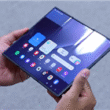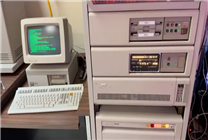Embracing the Past: A Journey with Vintage Computing
Summary
- Dave Plummer, a former Microsoft engineer, showcases a nostalgic project involving an antique hard drive.
- He connects a 200-pound DEC RA82 disk drive to a 40-year-old PDP-11/73 computer.
- Plummer emphasizes the unique experience of using period storage devices over modern alternatives.
In a fascinating display of nostalgic engineering, Dave Plummer, renowned for his pivotal role in the development of iconic features like Zip folders and task managers at Microsoft, has embarked on an intriguing project that bridges the gap between past and present. Recently, he shared a video demonstrating an ambitious endeavor: integrating a massive antique hard drive into a vintage computer from the early ’80s.
Frustrated with the monotony of modern storage solutions such as SD cards, which he described as "too boring," Plummer sought to revive the tactile and auditory experiences of computing from an era gone by. His quest was to utilize period-specific storage devices that not only come with their own limitations but also deliver unique sounds and rituals associated with their operation.
To fulfill this ambition, Plummer procured a DEC RA82 disk drive, a behemoth of engineering from the 1980s. This substantial device, featuring several 14-inch disks, weighs an impressive 200 pounds (approximately 90.72 kilograms) but offers merely 622MB of storage capacity. The size of the RA82 was so significant that Plummer found it necessary to acquire a hydraulic scissor lift simply to hoist it into a rack in his home, likening the experience to maneuvering an "ocean liner" into place.
Ultimately, Plummer successfully connected the RA82 disk drive to his DEC PDP-11/73 computer. After a series of comprehensive tests, including low-level formatting, stress testing, and creating a partition table along with a file system, he was able to install a Unix operating system. The process not only demonstrated his technical prowess but also highlighted the charm and allure of vintage computing.
In the face of expected criticism that such setups are "gorgeous but impractical," Plummer remained steadfast in his belief that pairing the RA82 with the PDP-11/73 is more than just a nostalgic venture. It serves as a testament to a bygone era’s educational value and beauty. The video ends with a satisfying demonstration of the "glorious noise" that the drive produces upon startup, making it a rewarding experience for enthusiasts and novices alike.
Plummer’s project underscores a growing trend among tech enthusiasts who seek to explore and engage with vintage technology. These enthusiasts appreciate the historical significance and unique user experiences that older devices provide, contrasting sharply with the fast-paced, streamlined interfaces of modern technology. The tactile feedback, the responsive sounds, and even the rituals involved in operating such systems stand in stark contrast to today’s often invisible digital solutions.
As nostalgia for past technologies continues to grow, Plummer’s journey is a compelling reminder of the inherent value that historical devices bring to our understanding of technological evolution. By connecting with these artifacts, he not only honors the legacy of computing but also revives a sense of wonder and engagement that many find lacking in contemporary technology.
In conclusion, Dave Plummer’s project exemplifies a unique melding of history and technology, inviting a deeper appreciation for the tools of the past. Through his work, he challenges the perception of what constitutes practical technology and encourages a re-evaluation of how we interact with our devices, urging a reconnection with the sensory experiences that make technology not just functional but also deeply enjoyable.
Key Takeaways
- Nostalgic Approach: Plummer’s project illustrates a revival of tactile interaction with technology through vintage devices.
- Educational Value: The RA82 drive serves as an educational tool for those interested in the history and evolution of computer technology.
- Community Engagement: This venture reflects the growing excitement among tech enthusiasts to engage with and learn from historical computing artifacts.
By embracing vintage technology, enthusiasts like Plummer illuminate the path of technological advancement while celebrating the unique stories ingrained in each device.





